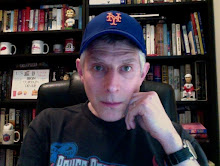 |
| The end of the line, styled as a throw-back, and, at $5.99, no longer really "cheap." |
MAD was the key to unlocking the truth about the adult universe, the hypocrisy, the vanity and inherent cynicism of every day life. Each issue was a cleverly disguised instruction manual, teaching kids how to see through, if not actually defeat, the bullshit being shoveled their way every day.
Every goddamned day.
MAD was dynamite. Now it's done.
After 64 years, America's greatest purveyor of subversive satirical shtick has published its final issue of new material. From here on in, it'll be all re-packaged greatest hits collections not unlike the quarterly Super Specials MAD churned out when I was a kid, only more so. Immortality through re-runs.
The cause of death: Obsolescence.
MAD outlived its usefulness, done in by a world crazier than the one it lampooned, superseded by TV bridezillas, bachelors and bachelorettes, by real housewives and teen moms, by Survivor, The Apprentice and by a social media landscape more shameless and self-referential than its editors ever imagined.
 |
| A Super Special reprint |
It sprung from the skull of publisher William M. Gaines and legendary artist Harvey Kurtzman as a full color comic book, something I only ever glimpsed as reprints packaged with those Super Specials.
That incarnation lasted just 23 issues before being transformed into the glossy-cover black and white illustrated magazine we came to know and love.
My dad got that first issue of the new MAD while serving in the U.S. Army and kept it long enough to give it to me together with a half dozen more issues of similar vintage, proving this type of MADness too could be hereditary.
 |
| Where it began: dad's July '55 issue |
In time, the magazine would turn its sights on Elvis Presley, Walt Disney and, unavoidably, politics, producing for its December 1956 issue a cover both timeless and iconic.
About 25 years later, I started reading MAD and, in 1976, became a subscriber.
I was 11 years old and wouldn't miss an issue for the next four years, spending lots of time with the so-called "usual gang of idiots" -- Al Jaffee, the father of the fold-in, purveyor of Snappy Answers to Stupid Questions; Dave Berg's The Lighter Side...; Antonio Prohias' Cold War-inspired Spy vs. Spy and Don Martin's epic onomatopoetic sound effects.
 |
| December '56, October '80 |
SHTOINK!!!
They repeatedly spoofed Star Trek and Star Wars which meant a great deal to an unrepentant geek like me. I remain forever grateful.
MAD was great fun.
Behind the humor, there were serious messages from the editors: they hated hypocrisy and war, drugs, poverty, bigotry, pollution and politicians.
Their send-up of The French Connection was titled What's the Connection? In it, Gene Hackman's "Cockeye" Doyle is an unabashed bigot telling every minority he's encounters -- real or imagined -- to go back to where they came from. That lesson stayed with me. Even as a kid, I got the point that that was wrong.
MAD taught generations of kids to think critically about what they were being told and sold by the establishment. Its writers' unsubtle message: People are generally full of crap.
They were of course right. For a time the formula worked and MAD had a little media empire going, one filled with paperback books, phonograph records and even a TV show.
 |
| Peak geek -- October 1976 |
MAD influenced all of them too.
Nine issues ago, its publishers attempted a re-launch, resetting the counter to issue 1 from 550, to no avail. The insanity of every day life had rendered MAD passably sane. Now, the magazine has wrapped up its role in educating America's youth, leaving disciples everywhere.
We're still out there, and we can see right through you.
-- Follow me on Twitter @paperboyarchive

No comments:
Post a Comment